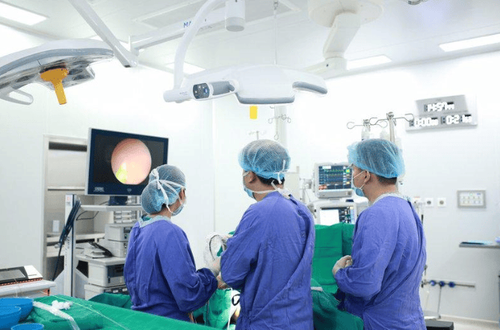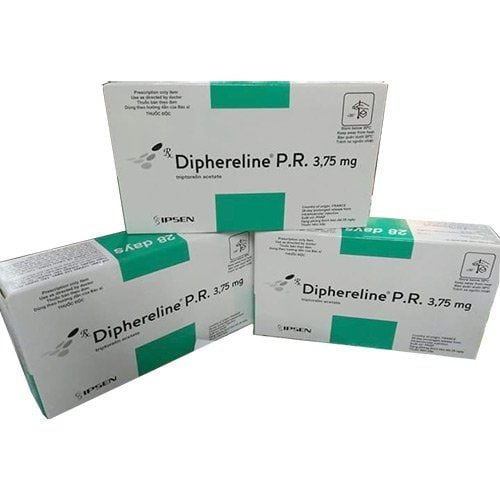This is an automatically translated article.
The article is professionally consulted by a doctor of Obstetrics and Gynecology, Vinmec Danang International General Hospital.Total hysterectomy in women approaching menopause means removal of both the uterus and ovaries. Women who have had a hysterectomy often experience a surgical menopause and often require hormone replacement therapy.
1. What is hysterectomy?
Hysterectomy (English: Hysterectomy) is surgery to remove the uterus. It may also involve cutting the cervix, ovaries, fallopian tubes, and other surrounding structures. Usually performed by a gynecologist, hysterectomy can be the total removal of the uterus and cervix, often referred to as a "total hysterectomy", or "partial hysterectomy". ” when only the body of the uterus is removed to the isthmus of the uterus and leaves the cervix.
This is a common gynecological surgery, for various reasons, in obstetrics, because the uterus does not contract well after childbirth, heavy bleeding due to placenta or severe infection in the uterus after childbirth...in gynecology, the most common pathology is uterine fibroids, uterine cancer... The hysterectomy makes the disease worse. Women can no longer menstruate, cannot become pregnant and give birth. This is the surgery that must be done, but sometimes it also leaves many physical and psychological changes for the woman.
2. Effects of hysterectomy

Phụ nữ sau khi cắt tử cung thường dẫn đến tình trạng mãn kinh
For women, menstruation reflects their gynecological life, menstruation occurs every month as a normal and natural phenomenon. When a woman has a total or partial hysterectomy, a woman no longer menstruates, leading to other changes, such as forgetfulness, forgetfulness, decreased libido... These are common changes. But in medicine, female genital physiology governs the entire genitalia, depending heavily on female sex hormones, secreted by the two ovaries.
Female reproductive physiology, when growing up, go through many periods of childhood, adolescence, pre-menopausal women and menopause. At menopause, a woman will no longer have periods, which is normal menopause. In the case of a hysterectomy, menopause will be caused by surgery.
In fact, during a conventional hysterectomy, there are cases where two appendages (ovaries and fallopian tubes) are left behind, and the ovaries continue to function and still secrete sex hormones. Although there are fewer women than before, the reason one branch of the uterine artery supplying blood to the ovary is often still ligated and cut, although there is still another source of supply to the ovary, which is the lumbosacral vasculature of the ovary. So the loss of period does not affect health much. If the ovaries are still intact, the patient only does not have a period, but later on, he still has perimenopause and menopause symptoms. At that time, the ovaries gradually weaken and are no longer able to secrete hormones. The changes that cause surgical menopause are more affected when the appendix is removed. Women who have had a hysterectomy often have surgical menopause and often require hormone replacement therapy.
3. Methods of hysterectomy

Dịch vụ phẫu thuật cắt tử cung nội soi của Bệnh viện Đa khoa Quốc tế Vinmec
Today, there are many methods of hysterectomy :
Classical method by laparotomy: Nowadays, there are less and less cases of hysterectomy by classical method, except the uterus is too large, too sticky because of inflammation, because of many previous surgeries. With this method, the patient has to stay in the hospital for a longer time, and the pain after surgery sometimes requires more pain relievers. In addition, the patient may experience more complications of abdominal surgery such as: intestinal adhesions, intestinal obstruction ...
Vaginal hysterectomy: With this method, the removed uterus is taken through the vagina. , the patient does not have a scar on the abdominal wall when successfully achieved high aesthetics. This is a rather difficult method for the surgeon, requiring the surgeon to have a lot of experience. Because of the difficulty, during surgery, it is possible to touch and injure adjacent organs such as perforation - tearing the bladder. , rectum, causing bleeding.. Sometimes the surgery becomes complicated.
Less invasive laparoscopic surgery: A fairly common method today in large hospitals with good equipment, with this method, the patient has no scar on the abdominal wall, less pain after surgery, less time. faster recovery and less hospital stay. The removed uterus is removed vaginally or crushed and removed from the abdomen through small trocar holes.
Robotic surgery: Vinmec is known as one of the first hospitals in Vietnam to apply robotic surgery in gynecological treatment. The robot equipped at Vinmec International General Hospital is a Da Vinci Robot made in the US. This is an advanced robot, with a sophisticated structure, with 4 arms that are almost perfectly simulated human movements.
Robot can penetrate narrow, deep, hard-to-reach places. No field of vision restriction like traditional methods, for optimal image quality. Safe, reduces the risk of complications from infection. Reducing pain after surgery for patients. Less blood loss, faster recovery time, very small surgical scars, so it is aesthetic.
Please dial HOTLINE for more information or register for an appointment HERE. Download MyVinmec app to make appointments faster and to manage your bookings easily.













